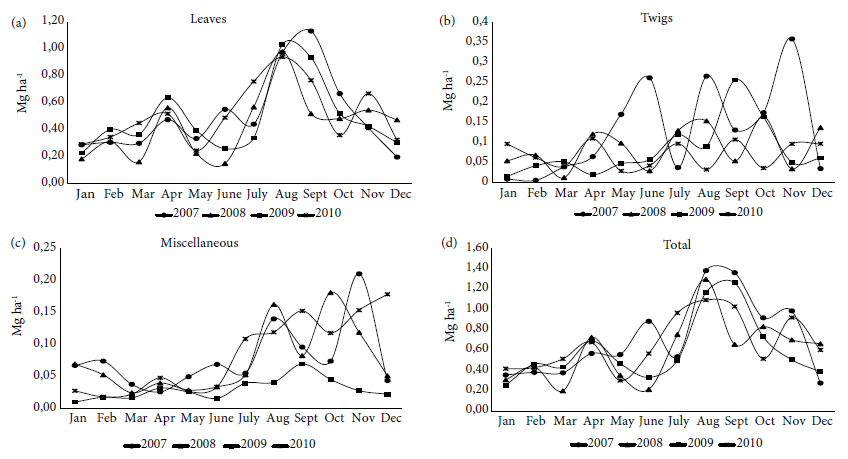| Advanced succession stage |
8.21 |
Pimenta et al. (2011Pimenta JA, Rossi LB, Torezan JMD, Cavalheiro AL, Bianchini E. Produção de serapilheira e ciclagem de nutrientes de um reflorestamento e de uma floresta estacional semidecidual no sul do Brasil. Acta Botanica Brasilica 2011; 25(1): 53-57. 10.1590/S0102-33062011000100008
https://doi.org/10.1590/S0102-3306201100...
) |
| 9.50 |
Pezzato & Wisniewski (2006Pezzato AW, Wisniewski C. Produção de serapilheira em diferentes seres sucessionais da floresta estacional semidecidual no oeste do Paraná. Floresta 2006; 36(1): 111-120. 10.5380/rf.v36i1.5596
https://doi.org/10.5380/rf.v36i1.5596...
) |
| 11.70 |
Pezzato & Wisniewski (2006Pezzato AW, Wisniewski C. Produção de serapilheira em diferentes seres sucessionais da floresta estacional semidecidual no oeste do Paraná. Floresta 2006; 36(1): 111-120. 10.5380/rf.v36i1.5596
https://doi.org/10.5380/rf.v36i1.5596...
) |
| 8.82 |
Pinto et al. (2009Pinto SIC, Martins SV, Barros NF, Dias HCT. Ciclagem de nutrientes em dois trechos de floresta estacional semidecidual na reserva florestal Mata do Paraíso em Viçosa, MG, Brasil. Árvore 2009; 33(4): 653-663. 10.1590/S0100-67622009000400008
https://doi.org/10.1590/S0100-6762200900...
) |
| 12.97 |
Toledo et al. (2002Toledo LO, Pereira MG, Menezes CEG. Produção de serapilheira e transferência de nutrientes em florestas secundárias localizadas na região de Pinheiral, RJ. Ciência Florestal 2002; 12(2): 9-16. 10.5902/198050981676
https://doi.org/10.5902/198050981676...
) |
| 6.78 |
Werneck et al. (2001Werneck MS, Pedralli G, Gieseke LF. Produção de serapilheira em três trechos de uma floresta semidecídua com diferentes graus de perturbação na Estação Ecológica do Tripuí, Ouro Preto, MG. Revista Brasileira de Botânica 2001; 24(2): 195-198. 10.1590/S0100-84042001000200009
https://doi.org/10.1590/S0100-8404200100...
) |
| 8.81 |
Pinto et al. (2009Pinto SIC, Martins SV, Barros NF, Dias HCT. Ciclagem de nutrientes em dois trechos de floresta estacional semidecidual na reserva florestal Mata do Paraíso em Viçosa, MG, Brasil. Árvore 2009; 33(4): 653-663. 10.1590/S0100-67622009000400008
https://doi.org/10.1590/S0100-6762200900...
) |
| Intermediary succession stage |
6.58 |
Werneck et al. (2001Werneck MS, Pedralli G, Gieseke LF. Produção de serapilheira em três trechos de uma floresta semidecídua com diferentes graus de perturbação na Estação Ecológica do Tripuí, Ouro Preto, MG. Revista Brasileira de Botânica 2001; 24(2): 195-198. 10.1590/S0100-84042001000200009
https://doi.org/10.1590/S0100-8404200100...
) |
| Initial succession stage |
6.31 |
Pinto et al. (2009Pinto SIC, Martins SV, Barros NF, Dias HCT. Ciclagem de nutrientes em dois trechos de floresta estacional semidecidual na reserva florestal Mata do Paraíso em Viçosa, MG, Brasil. Árvore 2009; 33(4): 653-663. 10.1590/S0100-67622009000400008
https://doi.org/10.1590/S0100-6762200900...
) |
| 5.09 |
Werneck et al. (2001Werneck MS, Pedralli G, Gieseke LF. Produção de serapilheira em três trechos de uma floresta semidecídua com diferentes graus de perturbação na Estação Ecológica do Tripuí, Ouro Preto, MG. Revista Brasileira de Botânica 2001; 24(2): 195-198. 10.1590/S0100-84042001000200009
https://doi.org/10.1590/S0100-8404200100...
) |
| 6.31 |
Pinto et al. (2009Pinto SIC, Martins SV, Barros NF, Dias HCT. Ciclagem de nutrientes em dois trechos de floresta estacional semidecidual na reserva florestal Mata do Paraíso em Viçosa, MG, Brasil. Árvore 2009; 33(4): 653-663. 10.1590/S0100-67622009000400008
https://doi.org/10.1590/S0100-6762200900...
) |
| Others |
Riparian forest |
10.00 |
Vital et al. (2004Vital ART, Guerrini IA, Franken WK, Fonseca RCB. Produção de serapilheira e ciclagem de nutrientes de uma floresta estacional semidecidual em zona ripária. Árvore 2004; 28(6): 793-800. 10.1590/S0100-67622004000600004
https://doi.org/10.1590/S0100-6762200400...
) |
| Gaps in forest |
5.97 |
Martins & Rodrigues (1999Martins SV, Rodrigues RR. Produção de serapilheira em clareiras de uma floresta estacional semidecidual no município de Campinas, SP. Revista Brasileira de Botânica 1999; 22(3): 405-412. 10.1590/S0100-84041999000300009
https://doi.org/10.1590/S0100-8404199900...
) |

